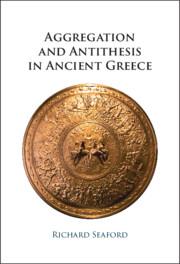Book contents
- Aggregation and Antithesis in Ancient Greece
- Aggregation and Antithesis in Ancient Greece
- Copyright page
- Contents
- Figures
- Preface
- Note on the Text
- Chapter 1 Defining Terms
- Chapter 2 Homer
- Chapter 3 Opposites in Ionian Cosmology
- Chapter 4 Opposites in the Cosmology of Magna Graecia
- Chapter 5 Visual Art from the Near East to Greece
- Chapter 6 The Unity of Opposites in the Fifth Century: Tragedy and Vase-Painting
- Chapter 7 Plato
- References
- Index of Principal Passages
- General Index
Chapter 6 - The Unity of Opposites in the Fifth Century: Tragedy and Vase-Painting
Published online by Cambridge University Press: 21 October 2025
- Aggregation and Antithesis in Ancient Greece
- Aggregation and Antithesis in Ancient Greece
- Copyright page
- Contents
- Figures
- Preface
- Note on the Text
- Chapter 1 Defining Terms
- Chapter 2 Homer
- Chapter 3 Opposites in Ionian Cosmology
- Chapter 4 Opposites in the Cosmology of Magna Graecia
- Chapter 5 Visual Art from the Near East to Greece
- Chapter 6 The Unity of Opposites in the Fifth Century: Tragedy and Vase-Painting
- Chapter 7 Plato
- References
- Index of Principal Passages
- General Index
Summary
This chapter discusses the increasing presence of antithesis, rather than aggregation, in fifth-century Greek historiography, tragedy and vase-painting. In certain key incidents and in narrative patterns in Herodotus and Attic tragedy, we find antithesis in the form of the unity of opposites and the reversal of an apparently stable situation. This reflects the influence of mystic initiation, Pythagorean thinking (in the case of Aeschylus), and, in a broader sense, the emergence of the polis, in which social oppositions are contained within a political unit. In fifth-century Attic vase-painting and sculptural groups, there is also a progressive shift from aggregation to antithesis, paralleling the pattern found in the newly emerging genres of historiography and tragedy. This too reflects the increasing prevalence of monetary exchange and interactions within the unified framework of the polis.
Information
- Type
- Chapter
- Information
- Aggregation and Antithesis in Ancient Greece , pp. 164 - 172Publisher: Cambridge University PressPrint publication year: 2025
Accessibility standard: Inaccessible, or known limited accessibility
Why this information is here
This section outlines the accessibility features of this content - including support for screen readers, full keyboard navigation and high-contrast display options. This may not be relevant for you.Accessibility Information
Content Navigation
Allows you to navigate directly to chapters, sections, or non‐text items through a linked table of contents, reducing the need for extensive scrolling.
Provides an interactive index, letting you go straight to where a term or subject appears in the text without manual searching.
Reading Order & Textual Equivalents
You will encounter all content (including footnotes, captions, etc.) in a clear, sequential flow, making it easier to follow with assistive tools like screen readers.
You get concise descriptions (for images, charts, or media clips), ensuring you do not miss crucial information when visual or audio elements are not accessible.
Visual Accessibility
You will still understand key ideas or prompts without relying solely on colour, which is especially helpful if you have colour vision deficiencies.
Structural and Technical Features
You gain clarity from ARIA (Accessible Rich Internet Applications) roles and attributes, as they help assistive technologies interpret how each part of the content functions.
